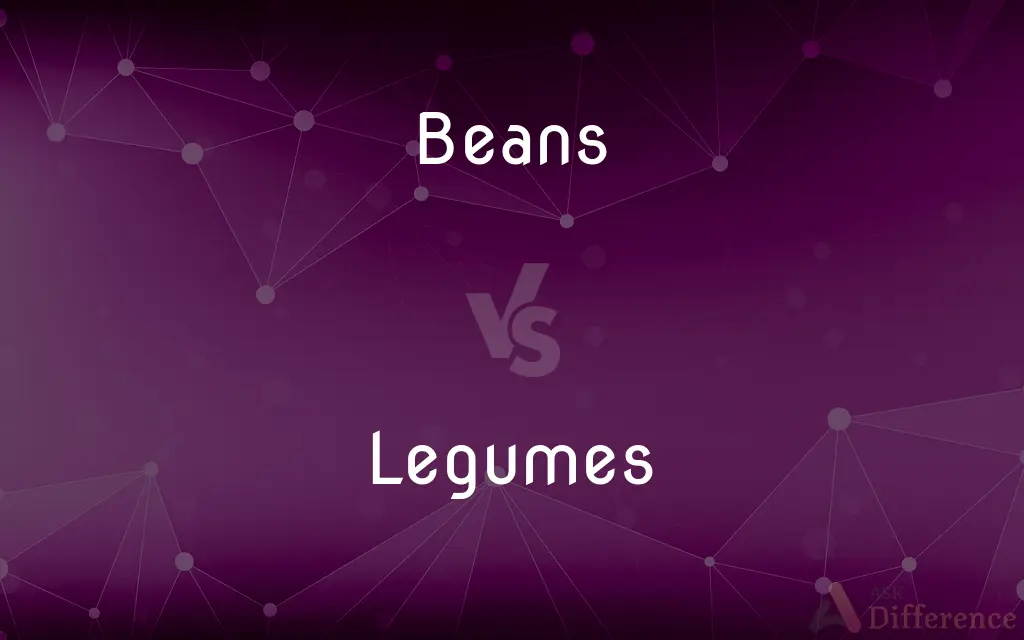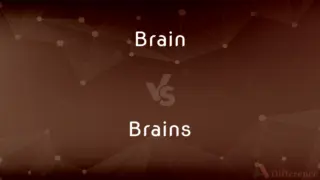Beans vs. Legumes — What's the Difference?
By Fiza Rafique & Maham Liaqat — Updated on May 8, 2024
Beans are specific seeds from the legume family, often used as food. Legumes encompass a broader category that includes all plants from the Fabaceae family, including beans, peas, and lentils.

Difference Between Beans and Legumes
Table of Contents
ADVERTISEMENT
Key Differences
Beans are a type of seed that is generally harvested for consumption. They belong to the legume family and are rich in protein, fiber, and vitamins. Legumes, on the other hand, include not only beans but also other plants like peas and lentils.
Beans are a dietary staple and are often grown specifically for their edible seeds. They come in various varieties, such as black, kidney, and pinto beans. Legumes are the overarching family that covers all types of pod-bearing plants, including chickpeas and soybeans.
Beans are grown and consumed worldwide due to their affordability and nutritional benefits. They are also versatile in cooking. Legumes provide a wider variety of plant species that can be consumed as seeds, pods, or sprouts.
Beans need specific cooking techniques to reduce natural toxins and enhance flavor. Whereas legumes encompass plants that may also be eaten raw or after minimal processing.
Comparison Chart
Definition
Seeds from plants within the legume family
All plants in the Fabaceae family, including beans
ADVERTISEMENT
Varieties
Black, kidney, navy, and pinto beans
Beans, peas, lentils, chickpeas, soybeans
Nutritional Value
High in protein, fiber, vitamins
Varies widely but generally nutrient-dense
Usage
Edible seeds used in cooking
Includes seeds, pods, and sprouts
Cooking Preparation
Requires thorough cooking
Some require minimal processing
Compare with Definitions
Beans
Seeds from leguminous plants used as food.
Black beans are a popular ingredient in Latin American cuisine.
Legumes
Edible seeds, pods, or sprouts from leguminous plants.
Lentils are a legume rich in protein.
Beans
High-protein legumes popular in vegetarian diets.
Pinto beans offer a protein-rich alternative to meat.
Legumes
Plants of the Fabaceae family, often bearing pods.
Peas and peanuts are different types of legumes.
Beans
Any variety of beans used in cooking.
Navy beans work well in soups and stews.
Legumes
Any plant from the Fabaceae family.
Soybeans are legumes used in many processed foods.
Beans
Edible legumes, often available dried or canned.
Kidney beans are great for chili.
Legumes
Nitrogen-fixing plants valuable for crop rotation.
Farmers often grow legumes to improve soil health.
Beans
Leguminous plants producing edible seeds.
Runner beans are grown for their edible pods.
Legumes
A broader category encompassing beans, peas, and similar plants.
Legumes contribute significantly to plant-based diets.
Beans
Any of various twining herbs of the genus Phaseolus in the pea family, native to the Americas, having leaves with three leaflets and variously colored flowers, and widely cultivated for their edible pods and seeds.
Legumes
A plant of the pea family.
Beans
A seed or pod of any of these plants.
Legumes
A pod of such a plant, which splits into two valves with the seeds attached to one edge of the valves.
Beans
Any of several related plants or their seeds or pods, such as the adzuki bean, broad bean, or soybean.
Legumes
Such a pod or seed used as food. Peas, beans, and lentils are legumes.
Beans
Any of various other plants or their seeds or fruits, especially those suggestive of beans such as the coffee bean or vanilla bean.
Legumes
Plural of legume
Beans
(Slang) A person's head.
Beans
Beans(Slang) A small amount
I don't know beans about investing.
Beans
Chiefly British A fellow; a chap.
Beans
To hit (another) on the head with a thrown object, especially a pitched baseball.
Beans
Plural of bean
Beans
S; drugs in pill form.
Popping beans
Beans
An insignificant value or amount.
Beans
A cut that reaches the hypodermis.
He told me he reached beans, I hope he’ll be okay.
Common Curiosities
Are peas considered beans?
No, peas are not beans but are a type of legume, like beans.
Are lentils and chickpeas considered beans?
No, lentils and chickpeas are not classified as beans; they are separate types of legumes with different botanical characteristics.
What makes legumes beneficial in agriculture?
Legumes can fix nitrogen in the soil, improving fertility and reducing the need for chemical fertilizers.
Are beans and legumes the same thing?
No, beans are a specific type of legume, while legumes include a broader category of pod-bearing plants.
Are beans suitable for people with gluten intolerance?
Yes, most beans are naturally gluten-free, making them a good protein source for individuals with gluten intolerance.
Can all legumes be eaten raw?
Not all legumes can be eaten raw; some, like beans, need to be cooked to remove natural toxins.
Is soy a legume or a bean?
Soy is a legume, and its seeds are sometimes referred to as soybeans.
How are beans classified within the legume family?
Beans are classified based on their seed type, pod characteristics, and botanical relationships within the legume family.
Why are beans often considered a good source of protein?
Beans contain high levels of plant-based protein, making them a valuable dietary source, especially for vegetarians and vegans.
Do legumes include nuts like peanuts?
Yes, peanuts are technically legumes because they grow underground in pods, similar to other leguminous plants.
What makes legumes a valuable addition to a balanced diet?
Legumes are rich in fiber, vitamins, and minerals, providing essential nutrients that support digestive health and can help prevent chronic diseases.
Why do some people experience digestive discomfort from beans?
Some people may have difficulty digesting beans due to their complex carbohydrates, which can cause gas and bloating.
Can eating beans and legumes regularly improve health?
Yes, consuming beans and legumes regularly can improve health by providing plant-based protein, promoting digestive health, and helping regulate blood sugar.
Is it necessary to soak all types of beans before cooking?
Soaking is beneficial for dried beans, as it reduces cooking time and improves digestibility. However, lentils and split peas typically don't require soaking.
How can the cooking process impact the nutrition of beans and legumes?
Proper soaking and cooking can reduce certain anti-nutrients and toxins, making beans and legumes easier to digest while retaining their nutritional value.
Share Your Discovery

Previous Comparison
Brain vs. Brains
Next Comparison
Uprising vs. RebellionAuthor Spotlight
Written by
Fiza RafiqueFiza Rafique is a skilled content writer at AskDifference.com, where she meticulously refines and enhances written pieces. Drawing from her vast editorial expertise, Fiza ensures clarity, accuracy, and precision in every article. Passionate about language, she continually seeks to elevate the quality of content for readers worldwide.
Co-written by
Maham Liaqat















































